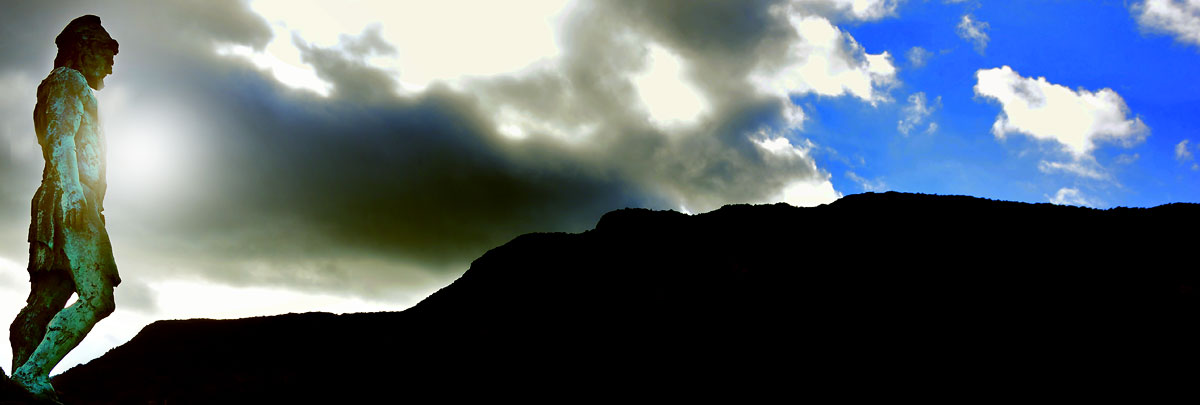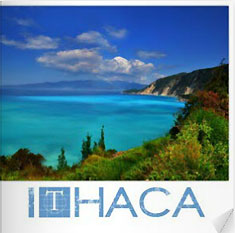Museums and Sites

In contrast to the rich history of Ithaca, the archaeological research has been comparatively limited, with a substantial amount of excavation taking place during the early 20th Century.
Archaeological History
William Gell, considered the pioneer of archaeological study on the island, began his scientifically based research in 1806, but did not continue with methodical excavations. Nevertheless he is credited with the discovery of a part of ancient inscription found near Vathy, probably from the Temple of Artemis.
After Gell, several other archaeologists came to Ithaca, some dealing illegally in antiquities and secretly undertaking excavations. Among these archaeologists were Leake (1806), Charles de Bosset (1810-1813) and Lee. However, Leakes studies recorded that there was a Spring at the Late Helladic cult site at Aetos. By the time it was properly excavated in 1932, it had dried up, but conclusions had been made that the cult was centered around it. Lee was in cooperation with Baron Stackelberg and divided the precious objects they found between them. Some of the objects thought to have been taken were a bronze prehistoric sword found at Aetos, similar to the one found at the Cave of Louizos, various pieces of gold jewelry, glass and clay bowls, pottery, tools, copper, silver and gold coins.
The local conqueror Guitera (1811-1814) plundered 200 tombs at the Aetos area, melted some of the gold and silver coins and sold the metal with the other treasures abroad.
After the Unification of Ithaca with Greece in 1864, there were more organized excavations. Schliemann was the first to systematically organize the digs in 1868 and 1878. Other archaeologists followed until the beginning of the 20th century. From the research and excavations of this period a variety of important objects were found. Most of them are now either in the two museums of Ithaca or in the National Archaeological Museum of Athens.
The excavations in 1930 at the hill of Pilicata, under Heurtley's supervision, British School at Athens, was considered one of the most important. A variety of discoveries proved that the area was inhabited as early as the Neolithic Period. A wall surrounding the hill, foundations of buildings, graves of the Mycenaean period and different objects indicate that civilization continued and that this area was of great significance.
A significant excavation took place in Polis at Louizos Cave by Heurtley's assistant, Sylvia Benton of the BSA. The findings there, proved that it had been a place of worship from 2500 B.C. until the 1st century A.D. A clay mask, that of a female, with Odysseus' name engraved on it, was found in the cave. This mask is another strong indication that links the identity of the island to that of Homer's writings. Ithacan arts and crafts were very similar to those in other Greek Kingdoms of significance, and even further afiield during that period. The Ithacans were also skilled potters, judging by the local pottery.
In 1931 and 1932, Heurtley undertook excavations at the Aetos area. He discovered ruins of buildings, ancient temples, everyday articles and many Corinthian objects of worship. Also of significance are the nine different types of coins found from the 4th and 3rd centuries B.C. These coins refer to Ithaca and Odysseus as well as various symbols or gods.
From the research and excavations that have taken place, it has been proven that civilization has existed on Ithaca for the past 6000 years with some periods showing large settlements. The main settlement was on the northern peninsula of Ithaca, around the hill of Pilikata, later, at Aetos.
Over the decades, ruins from the Roman period, along with other previous periods, have been discovered around Vathy and Southern Ithaca, but the progress has been slow. Excavations of Ithaca are considered to be incomplete. It is believed that there are numerous objects and ruins waiting to be discovered so that they may enlighten us further about the ancient history of Ithaca.
Archeological Sites
Aetos
Excavated in the 1930s by the British School of Athens, Aetos, Southern Ithaca, revealed itself to be a significant sanctuary site with cult use in the 9th Century B.C. and with perhaps even a temple around 780 B.C. There was a huge influx of Corinthian votive offerings during the latter period and Finds from all over the compass were excavated. These included amber beads from Italy or the Adriatic, amulets in the form of small bronze vessels, similar to those from Macedonia, stone scaraboid seals from Cilicia and a small granulated gold finial in the form of a snake's head from Crete.
Ancient Alalcomai
Ancient Alalcomai is located on a hill above the small town of Piso Aetos. Today the 6th century B.C. ruins of the acropolis of Alalcomai remain.
Spring of Aretousa
Located 5 kilometres (3 miles) south of Valhy at the far southeast corner of Ithaca is the Spring of Aretousa. This is the fabled spring where Odysseus' swineherder, Eumaeus, brought his pigs to drink.
Homers School
On the mountain below Exoghi and above Platrithias in the north of Ithaca lay the ruins believed to be that of Homers School. The site has been excavated in recent years by the University of Ioannina, Greece. There is access from a track leading up from Geyfiri Restaurant in Platrithias or by a dirt road which starts at the first bend of the road to Exoghi.
Monastery of Katharon
This monastery was built at the end of the 17th century and was dedicated to the Panaghia Katharotissa. It is located on Mt. Neritos at a height of 600 meters (1,967 feet). From the monastery there are views of Vathy and east towards the Gulf of Patras. There are two alternatives to get there, by road through Stavros and through Anoghi or via the main road.
Monastery of Taxiarchi
The Monastery of the Archangels is located southwest of Vathy. It was built in the 17th century.
Cave of the Nymphs
Also known as Marmarospilia, the Cave of the Nymphs is where Odysseus hid the gifts of the Phaeacians after his return from Troy. The cave is west of Vathy near the main road and is posted well.
Polis Cave
Located on the north side of the Polis Bay, this cave is thought to have been the centre for worships through early Greek civilization. Many clay vessels have been found, mostly Mycenaean. Although well signposted in Polis Bay on the North of the island, the ancient cave sanctuary is no longer visible since its final collapse in the 1953 earthquake. The British School at Athens excavated the site in the 1930s, all the finds from which are in the Stavros Museum. The excavations revealed that the site had accumulated some late Mycenaean and Early Protogeometric finds, however, from the 8th Century B.C. onwards, the cult continued without break into Roman Rule. The most significant finds were the fine Geometric bronze tripods dedicated there and a fragment of a locally made female theatrical mask dating from the 2 nd to the 3 rd Century B.C. Approximately one hundred were excavated, however, one fragment was inscribed with ‘Efhin Odyccei' and, in another direction, ‘O deina aneth I ken' meaning ‘Votive offering to Odysseus, so and so dedicated it.' The Polis Cave sanctuary was of significant importance judging by the finds excavated and it is reasonable to connect this importance with the Odyssey.
Early Helladic Settlement
A kilometer from Stavros at Pilikata, one can see the ruins of an ancient settlement. The area's archaeological findings are exhibited in a small collection. Pilikata has today, and most likely in the past, a supply of first-rate drinking water at only a few metres below the surface, which would make it a prime place to have a settlement. It was excavated by the British School in the 1930s, when the archaeologist Vollgraff found prehistoric shards on the site and the visible remains of an ancient circuit wall. Most of the wall had collapsed and the blocks had been reused in buildings and in the walls that terraced the hillside. However, towards the North end, around 15 blocks were, if not far off, in situ. Around 2200 B.C. simple houses were built within the circuit walls with rubble walls that were thatched with mud and reeds, but at some point in occupation, a more substantial building of ashlar masonry was erected at the highest point. A burial was also uncovered within a pottery vessel known as a ‘pithos'. Obsidian (stone) blades and flakes show their connection with their neighbours to the East. Mycenaean pottery and Minyan pottery was also discovered, possibly by the same people that introduced new burial customs on Lefkada. After the beginning of the 12 th Century B.C., the settlement came to an end. The site is one of several that have been suggested to be the place of the Palace of Odysseus. As written by Homer, 3 harbours were visible from the summit. From this point we can see Polis Bay to the West, Aphales bay to the North and Frikes Bay to the East. The Stavros Museum is also on the Pilikata Hill, and is where all the finds from these excavations are stored.
Museums
Stavros Museum
Monday: Closed
Tuesday - Sunday 08.30 - 15.00
The museum contains various finds from Northern Ithaca, spanning from the Early Helladic to the Roman Periods. The museum was built in 1933 and in 1994 the building was repaired and the exhibition, rearranged.
Items in the exhibition include:-
1.Fragments of large, bronze tripods from Polis Cave, dated 9th--8th centuries BC.
2.Clay plate with a representation of a cock. It was found in Polis Bay and dates back to the 7th century BC.
3.Fragments of a clay mask with an incised inscription 'deddicated to Odysseus' dated back to the 1st or 2nd century BC.
4.Stone Relief bearing a representation of dancing Nymphs. It was found at Polis Cave and dates back to the Hellenistic period.
Vathy Museum
Monday: Closed
Tuesday - Sunday 08.30 - 15.00
Phone: (+30) 26740-32200
The museum contains excavation finds from Piso Aetos, dating from the Geometric to the Roman period and a remarkable collection of pottery dated to the Geometric period, as well as items from Polis Cave. Items of the exhibition include -
1.A ring-shaped vase that has angular walls and is decorated with narrow bands on the sides of the ring, hatched triangles on the neck and panels with diagonals on the handle, dated to the end of the Late Geometric period.
2.A Votive inscription that mentions the Goddesses Athena and Hera. It was found at Polis Cave and dates from the Late Archaic period.
The Cultural Centre of Ithaki
Located in Vathy, the Cultural Centre houses an interesting and rich library which displays many rare books, among which are only existing edition of the Odyssey and the Iliad in Japanese and the complete works of Agios Athanasios dating from 1686.
The Folklore and Cultural Museum
The Folklore and Cultural Museum of Ithaca is situated in Vathy behind the Agricultural Bank. The building was once an old generating station. This new museum is a testament to the life of the inhabitants of Ithaca during the colonial period of the island and exhibits fully assembled bedrooms, kitchen and sitting-rooms from that period, as well as photographs of the devastating earthquakes of 1953.
Click Here for a quick look inside
Special thanks to Victoria McGuiness for additional information on the Sites around Ithaca.

